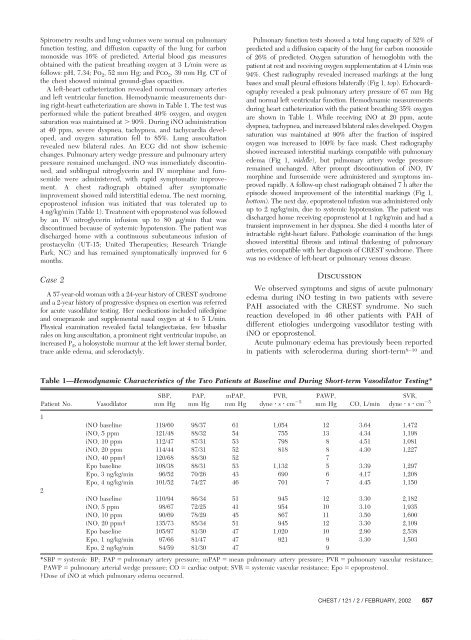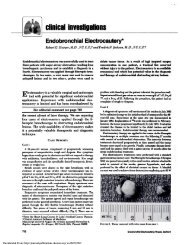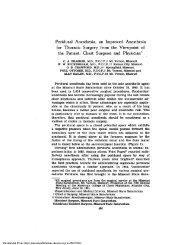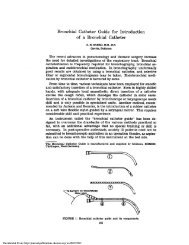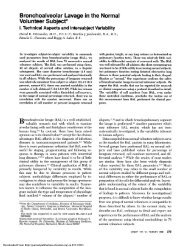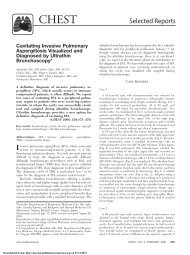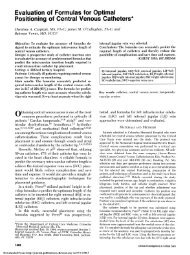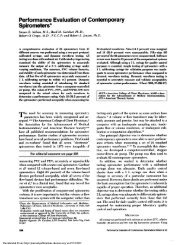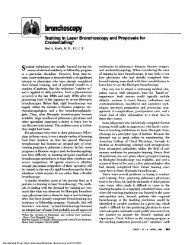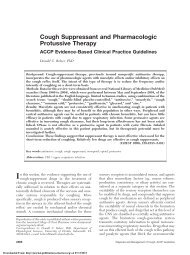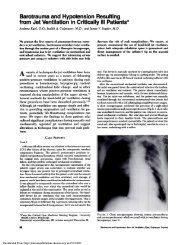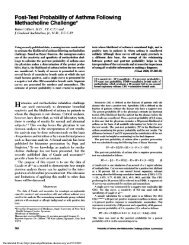Pulmonary Edema Caused by Inhaled Nitric Oxide Therapy in Two ...
Pulmonary Edema Caused by Inhaled Nitric Oxide Therapy in Two ...
Pulmonary Edema Caused by Inhaled Nitric Oxide Therapy in Two ...
Create successful ePaper yourself
Turn your PDF publications into a flip-book with our unique Google optimized e-Paper software.
Spirometry results and lung volumes were normal on pulmonary<br />
function test<strong>in</strong>g, and diffusion capacity of the lung for carbon<br />
monoxide was 16% of predicted. Arterial blood gas measures<br />
obta<strong>in</strong>ed with the patient breath<strong>in</strong>g oxygen at 3 L/m<strong>in</strong> were as<br />
follows: pH, 7.34; Po 2, 52 mm Hg; and Pco 2, 39 mm Hg. CT of<br />
the chest showed m<strong>in</strong>imal ground-glass opacities.<br />
A left-heart catheterization revealed normal coronary arteries<br />
and left ventricular function. Hemodynamic measurements dur<strong>in</strong>g<br />
right-heart catheterization are shown <strong>in</strong> Table 1. The test was<br />
performed while the patient breathed 40% oxygen, and oxygen<br />
saturation was ma<strong>in</strong>ta<strong>in</strong>ed at 90%. Dur<strong>in</strong>g iNO adm<strong>in</strong>istration<br />
at 40 ppm, severe dyspnea, tachypnea, and tachycardia developed,<br />
and oxygen saturation fell to 85%. Lung auscultation<br />
revealed new bilateral rales. An ECG did not show ischemic<br />
changes. <strong>Pulmonary</strong> artery wedge pressure and pulmonary artery<br />
pressure rema<strong>in</strong>ed unchanged. iNO was immediately discont<strong>in</strong>ued,<br />
and subl<strong>in</strong>gual nitroglycer<strong>in</strong> and IV morph<strong>in</strong>e and furosemide<br />
were adm<strong>in</strong>istered, with rapid symptomatic improvement.<br />
A chest radiograph obta<strong>in</strong>ed after symptomatic<br />
improvement showed mild <strong>in</strong>terstitial edema. The next morn<strong>in</strong>g,<br />
epoprostenol <strong>in</strong>fusion was <strong>in</strong>itiated that was tolerated up to<br />
4 ng/kg/m<strong>in</strong> (Table 1). Treatment with epoprostenol was followed<br />
<strong>by</strong> an IV nitroglycer<strong>in</strong> <strong>in</strong>fusion up to 80 g/m<strong>in</strong> that was<br />
discont<strong>in</strong>ued because of systemic hypotension. The patient was<br />
discharged home with a cont<strong>in</strong>uous subcutaneous <strong>in</strong>fusion of<br />
prostacycl<strong>in</strong> (UT-15; United Therapeutics; Research Triangle<br />
Park, NC) and has rema<strong>in</strong>ed symptomatically improved for 6<br />
months.<br />
Case 2<br />
A 57-year-old woman with a 24-year history of CREST syndrome<br />
and a 2-year history of progressive dyspnea on exertion was referred<br />
for acute vasodilator test<strong>in</strong>g. Her medications <strong>in</strong>cluded nifedip<strong>in</strong>e<br />
and omeprazole and supplemental nasal oxygen at 4 to 5 L/m<strong>in</strong>.<br />
Physical exam<strong>in</strong>ation revealed facial telangiectasias, few bibasilar<br />
rales on lung auscultation, a prom<strong>in</strong>ent right ventricular impulse, an<br />
<strong>in</strong>creased P 2, a holosystolic murmur at the left lower sternal border,<br />
trace ankle edema, and sclerodactyly.<br />
<strong>Pulmonary</strong> function tests showed a total lung capacity of 52% of<br />
predicted and a diffusion capacity of the lung for carbon monoxide<br />
of 26% of predicted. Oxygen saturation of hemoglob<strong>in</strong> with the<br />
patient at rest and receiv<strong>in</strong>g oxygen supplementation at 4 L/m<strong>in</strong> was<br />
94%. Chest radiography revealed <strong>in</strong>creased mark<strong>in</strong>gs at the lung<br />
bases and small pleural effusions bilaterally (Fig 1, top). Echocardiography<br />
revealed a peak pulmonary artery pressure of 67 mm Hg<br />
and normal left ventricular function. Hemodynamic measurements<br />
dur<strong>in</strong>g heart catheterization with the patient breath<strong>in</strong>g 35% oxygen<br />
are shown <strong>in</strong> Table 1. While receiv<strong>in</strong>g iNO at 20 ppm, acute<br />
dyspnea, tachypnea, and <strong>in</strong>creased bilateral rales developed. Oxygen<br />
saturation was ma<strong>in</strong>ta<strong>in</strong>ed at 90% after the fraction of <strong>in</strong>spired<br />
oxygen was <strong>in</strong>creased to 100% <strong>by</strong> face mask. Chest radiography<br />
showed <strong>in</strong>creased <strong>in</strong>terstitial mark<strong>in</strong>gs compatible with pulmonary<br />
edema (Fig 1, middle), but pulmonary artery wedge pressure<br />
rema<strong>in</strong>ed unchanged. After prompt discont<strong>in</strong>uation of iNO, IV<br />
morph<strong>in</strong>e and furosemide were adm<strong>in</strong>istered and symptoms improved<br />
rapidly. A follow-up chest radiograph obta<strong>in</strong>ed 7 h after the<br />
episode showed improvement of the <strong>in</strong>terstitial mark<strong>in</strong>gs (Fig 1,<br />
bottom). The next day, epoprostenol <strong>in</strong>fusion was adm<strong>in</strong>istered only<br />
up to 2 ng/kg/m<strong>in</strong>, due to systemic hypotension. The patient was<br />
discharged home receiv<strong>in</strong>g epoprostenol at 1 ng/kg/m<strong>in</strong> and had a<br />
transient improvement <strong>in</strong> her dyspnea. She died 4 months later of<br />
<strong>in</strong>tractable right-heart failure. Pathologic exam<strong>in</strong>ation of the lungs<br />
showed <strong>in</strong>terstitial fibrosis and <strong>in</strong>timal thicken<strong>in</strong>g of pulmonary<br />
arteries, compatible with her diagnosis of CREST syndrome. There<br />
was no evidence of left-heart or pulmonary venous disease.<br />
Discussion<br />
We observed symptoms and signs of acute pulmonary<br />
edema dur<strong>in</strong>g iNO test<strong>in</strong>g <strong>in</strong> two patients with severe<br />
PAH associated with the CREST syndrome. No such<br />
reaction developed <strong>in</strong> 46 other patients with PAH of<br />
different etiologies undergo<strong>in</strong>g vasodilator test<strong>in</strong>g with<br />
iNO or epoprostenol.<br />
Acute pulmonary edema has previously been reported<br />
<strong>in</strong> patients with scleroderma dur<strong>in</strong>g short-term8–10 and<br />
Table 1—Hemodynamic Characteristics of the <strong>Two</strong> Patients at Basel<strong>in</strong>e and Dur<strong>in</strong>g Short-term Vasodilator Test<strong>in</strong>g*<br />
Patient No. Vasodilator<br />
SBP,<br />
mm Hg<br />
PAP,<br />
mm Hg<br />
mPAP,<br />
mm Hg<br />
PVR,<br />
dyne s cm 5<br />
PAWP,<br />
mm Hg CO, L/m<strong>in</strong><br />
SVR,<br />
dyne s cm 5<br />
1<br />
iNO basel<strong>in</strong>e 119/60 98/37 61 1,054 12 3.64 1,472<br />
iNO, 5 ppm 121/48 88/32 54 755 13 4.34 1,198<br />
iNO, 10 ppm 112/47 87/31 53 798 8 4.51 1,081<br />
iNO, 20 ppm 114/44 87/31 52 818 8 4.30 1,227<br />
iNO, 40 ppm† 120/68 88/30 52 7<br />
Epo basel<strong>in</strong>e 108/38 88/31 53 1,132 5 3.39 1,297<br />
Epo, 3 ng/kg/m<strong>in</strong> 96/52 70/26 43 690 6 4.17 1,208<br />
Epo, 4 ng/kg/m<strong>in</strong> 101/52 74/27 46 701 7 4.45 1,150<br />
2<br />
iNO basel<strong>in</strong>e 110/94 86/34 51 945 12 3.30 2,182<br />
iNO, 5 ppm 98/67 72/25 41 954 10 3.10 1,935<br />
iNO, 10 ppm 90/69 78/29 45 867 11 3.50 1,600<br />
iNO, 20 ppm† 135/73 85/34 51 945 12 3.30 2,109<br />
Epo basel<strong>in</strong>e 105/97 81/30 47 1,020 10 2.90 2,538<br />
Epo, 1 ng/kg/m<strong>in</strong> 97/66 81/47 47 921 9 3.30 1,503<br />
Epo, 2 ng/kg/m<strong>in</strong> 84/59 81/30 47 9<br />
*SBP systemic BP; PAP pulmonary artery pressure; mPAP mean pulmonary artery pressure; PVR pulmonary vascular resistance;<br />
PAWP pulmonary arterial wedge pressure; CO cardiac output; SVR systemic vascular resistance; Epo epoprostenol.<br />
†Dose of iNO at which pulmonary edema occurred.<br />
Downloaded From: http://journal.publications.chestnet.org/ on 04/02/2013<br />
CHEST / 121 /2/FEBRUARY, 2002 657


